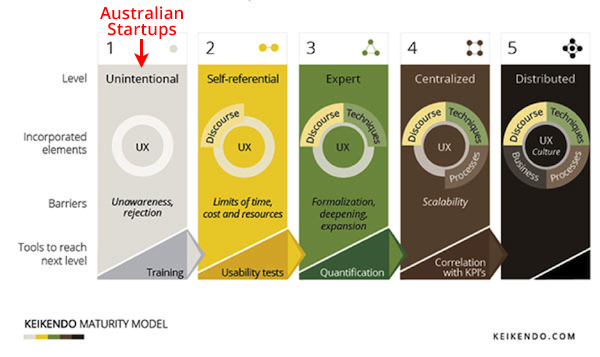Last week I attended Tech23 again, third year in a row and as usual there were some great ideas at varying levels of maturity. Each year I’ve gone I have watched through the lens of user experience design and you will find the impressions and observations in my blogs from each year. This year I was pleased to notice the evolution of UX within Australian startups, But I can’t quite work out if its me or them thats changed.
Its likely that over the last year my perceptions have altered and become somewhat better honed due to my own maturity in the field. I’ve learned to better understand the faces of UX, become less dogmatic and prescriptive and really supported the democratisation of the work.
So here’s what I found myself thinking. Startups are deep inside the experiences they are building. They are in a tight feedback loop with their customers, they are deep domain experts, and the very nature of their goal is to reframe existing problems in new ways to find new markets.
And if there has been an educational shift from the startup world in Australia, it is that they are listening and learning from their customers and a vocabulary is developing now to reference this activity. I felt for the first time this year at Tech23 this came through quite clearly. There were the usual contextual ranges: health always has good customer engagement but they were clearer about why those customers were the market; industry was a lot clearer this year about the users they were considering and also including more in their investigations for market.
The panels had better questions about audiences and customers this year too, and again in the language used rather than the content – where “users” were referenced more by their type instead eg patients, architects or van drivers and more empathy was displayed about the customers or audiences who are no longer a faceless market segment providing a source of income.
So this leads me to a relieving insight. I think I have been jousting at windmills in an attempt to design a better design process (a nasty habit designers can have) for startups when really they are just fine now.
One the final slides in my presentation about working with startups for two years is a point about business and design maturity. It really struck me last week that these are inseparable.
UX maturity is directly related to business maturity. Startups are embryonic and very organic. Small teams easily facilitate good communication and contact with customers or audiences. The founders or early stage team over time grow in distance from their beloved customer or audiences, and of course loose touch. To support this further to this we see evidence of ux being taken on board at various stages as the business and its offerings grows to unpick and redesign the services based. Workloads increase design solutions become more complex so specialists are brought in, same as hiring a financial manager or a technical lead to head up a team. This may also contribute to the startup model being adopted by large organisations for dedicated internal teams.

So I think the best way to work with startups is teaching them how to fish:
- How to listen to and manage customer feedback so development isn’t reactive
- Help them understand how to triangulate passive and active user feedback (eg direct feedback + analytics + user or A/B testing) so they will have better clarity and less bias from noisy customers.
Because there is no denying that the larger a business gets, the more that direct exposure to the users is diluted or distanced and at some point specialists are needed to come in an unpick and align all the complexities. I don’t think it can happen any other way. Organic, nimble activities come naturally to small teams. I don’t think we can strategically UX design an Australian startup. I think we can be boggy and get in their way unless we ease their work by being a frictionless cross discipline member of the team working on deliverables as well (eg front end or visual design) When engaging with a business that may have started as a startup I reckon it might be worthwhile to check in from time to time with the founders about their original passion and vision, where they succeeded and failed and keep that as some kind of proposition pole star.
This all matches my own work and results with NICTA startups/spinouts too. It falls roughly into categories:
- Where startups want help with their build we:
- deep dive into the domain with them
- investigate their knowledge of the customer
- do a bit of desk research
- provide workflows for interaction design
- easily bootstrapped UI guidance
- provide guidance or assistance on testing.
- When we do work supplying a new technology solution for large industry players or government:
- there is more insight development work
- workflow and service impact mapping
- concepts and rapid prototyping in iterations
- negotiating with stakeholders and established business needs
- eventually leading to UI and testing activities.
I’ve also cultural questions particular to Australia (all hands pitch in, not good with authority) and I think there would be personality types (eg highly motivated, keenly smart) that would also contribute to this, but that I don’t have enough insight on either of these.






